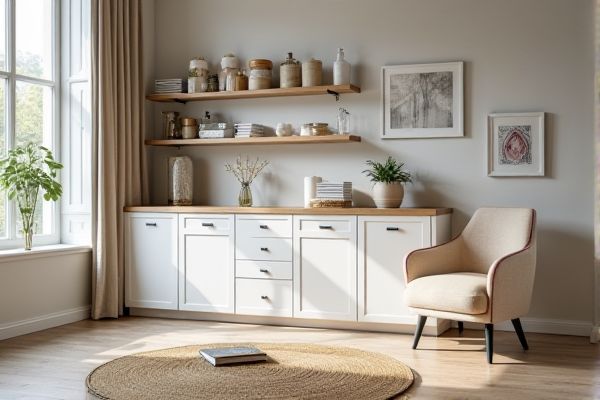
Wall-mounted bins save valuable floor space and create a cleaner, more organized environment, ideal for smaller areas or where mobility is a concern. Freestanding bins offer greater flexibility in placement and capacity, making them suitable for high-traffic zones; explore the benefits and drawbacks of each to determine which option best fits your needs.
Table of Comparison
| Feature | Wall-Mounted Bins | Freestanding Bins |
|---|---|---|
| Installation | Requires wall mounting; fixed position | No installation needed; easy to move |
| Space Efficiency | Maximizes floor space; ideal for small areas | Requires floor space; less efficient in tight spaces |
| Capacity | Usually smaller capacity | Typically larger capacity |
| Mobility | Stationary; fixed to wall | Portable; easy to relocate |
| Durability | Securely mounted; stable | May tip or move if not weighted |
| Cleaning & Maintenance | Easier to clean floor underneath | May obstruct cleaning under bin |
| Common Usage | Public restrooms, offices | Outdoor areas, kitchens, general waste |
Introduction to Wall-Mounted and Freestanding Bins
Wall-mounted bins save floor space and offer a streamlined, modern look ideal for small or high-traffic areas. Freestanding bins provide versatile placement options and larger capacities, making them suitable for offices and public spaces. Choosing between these options depends on your available space and waste disposal needs.
Design and Space-Saving Benefits
Wall-mounted bins offer a sleek design that maximizes floor space by attaching directly to walls, making them ideal for small or high-traffic areas. Freestanding bins provide flexible placement options but often occupy more floor space, potentially limiting room flow and accessibility. Your choice depends on space availability and aesthetic preferences, with wall-mounted options excelling in compact, modern environments.
Installation and Setup Requirements
Wall-mounted bins require secure attachment to walls using anchors or screws, often needing professional installation for optimal stability, making them ideal for saving floor space in compact areas. Freestanding bins offer flexible placement without the need for drilling or wall damage, allowing easy relocation and quick setup, suitable for dynamic environments. Your choice depends on available wall support and whether you prioritize fixed positioning or mobility.
Durability and Material Comparisons
Wall-mounted bins are typically crafted from heavy-duty materials like stainless steel or reinforced plastic, offering enhanced durability against impact and environmental exposure, making them ideal for high-traffic or outdoor areas. Freestanding bins often use lighter materials such as polypropylene or aluminum, which provide portability but may be more prone to wear, dents, and corrosion over time. The choice of material directly affects maintenance requirements and lifespan, with wall-mounted units generally delivering longer-term performance in demanding settings.
Accessibility and User Convenience
Wall-mounted bins offer enhanced accessibility by being positioned at eye level or within easy reach, reducing the need to bend or move significantly, which is ideal for users with mobility challenges. Freestanding bins, while often providing larger capacity, may require more floor space and can be less convenient to access in tight or crowded areas. The choice between the two depends on the specific environment and user needs, with wall-mounted bins prioritizing space efficiency and ease of use.
Capacity and Storage Efficiency
Wall-mounted bins maximize storage efficiency by utilizing vertical space, freeing up floor area for better organization in smaller rooms. Their limited capacity suits compact storage needs, ideal for keeping frequently used items within easy reach. Freestanding bins offer larger capacity options, accommodating bulkier waste or storage requirements but require more floor space.
Aesthetic Appeal and Style Options
Wall-mounted bins offer a sleek, space-saving design that enhances modern interiors by creating a minimalist look, while freestanding bins provide a wider variety of styles and colors to complement diverse decor themes. You can select wall-mounted options with concealed mounting hardware for a seamless aesthetic or choose freestanding bins that act as decorative accents with customizable finishes and patterns. The choice between these bin types ultimately depends on your preference for either streamlined elegance or versatile, eye-catching style elements.
Maintenance and Cleaning Differences
Wall-mounted bins minimize floor contact, reducing dust accumulation and simplifying floor cleaning, while freestanding bins require more effort to clean around their bases. You can easily wipe wall-mounted bins at eye level without bending, whereas freestanding bins often collect dirt underneath, demanding frequent floor maintenance. Choosing wall-mounted bins can streamline your cleaning routine and improve overall hygiene.
Cost and Value Considerations
Wall-mounted bins typically offer cost savings by utilizing vertical space, reducing floor clutter, and often requiring less material compared to freestanding bins, which can lead to lower purchase and installation costs. Freestanding bins provide greater flexibility in placement and higher capacity options but generally come with higher price points due to their larger size and more complex design. Evaluating the cost-effectiveness depends on space constraints, maintenance expenses, and long-term value derived from durability and usability in specific environments.
Choosing the Right Bin for Your Needs
Wall-mounted bins save floor space and are ideal for small areas, offering easy accessibility and a cleaner look. Freestanding bins provide greater capacity and flexibility, allowing you to move and position them wherever needed. Consider your room size, waste volume, and maintenance convenience to choose the right bin that fits your lifestyle and space requirements.
 homyna.com
homyna.com